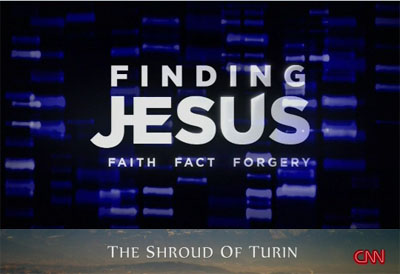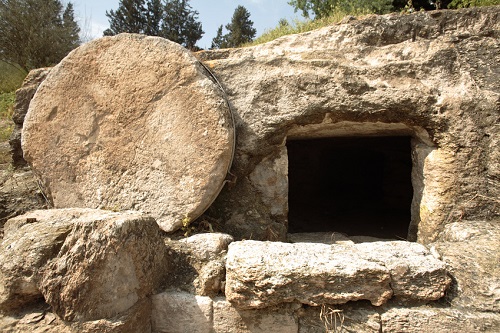|
Summary |
||
| In their article “Is the Shroud of Turin Authentic – or Is it a Forgery” Creation Ministries International (CMI) supports the theory that the Shroud of Turin is not the authentic burial shroud of Christ – it is a medieval forgery. This article refutes that theory, along with the main reasons CMI gives for rejecting authenticity.
This article relies primarily on the testimony of Shroud of Turin Research Project (STRP) members and other expert testimony to demonstrate there is a wealth of evidence CMI apparently did not consider before drawing their conclusions. This article is intended to inform the reader of those evidences and make available the testimony of the STRP members and other expert witnesses so that readers may judge for themselves whether CMI has reached the correct conclusion. It is the position of this article that they did not. The reader is encouraged to click on the links to view the referenced testimonies. |
Category Archives: Shroud of Turin
Are Biblical accounts copied from pagan religions? Part 2. The Resurrection
Since the original sin in the garden of Eden, mankind has searched for reasons not to believe God so he could live a life independent of God. In the garden, the serpent convinced Eve not to trust God. Why? Supposedly because God was holding back the knowledge of good and evil to the detriment of Adam and Eve. The serpent suggested God was wrong f0r withholding that knowledge, but that if they were to discover the truth, they would be “like God”. (Gen 3.5) That was a big lie. God was indeed withholding the knowledge of evil, but he was not wrong in doing so because he knew that (experiential) knowledge of evil (like disobeying God) would lead to death. And the biggest irony is – they were already like God (Gen 1.26), there was nothing to be gained from what the serpent offered.
Today there is another lie circulating to destroy belief in God: The claim that the biblical accounts are not history, but rather stories borrowed or stolen and then adapted from the made up stories of pagan religions. If there’s no reason to believe the pagan religions, then there’s no reason to believe a made up story based on it either. Continue Reading
“Finding Jesus” – the Shroud of Turin – A Review
 |
The first episode of the new CNN Series “Finding Jesus – Faith Fact Forgery” uses selective evidence to support the unwarranted conclusion that the Shroud of Turin is a forgery. |
Sunday night CNN launched a new documentary series on the Christian faith titled “Finding Jesus: Faith, Fact, Forgery”. The first episode, “The Shroud of Turin” was, as the title implies, a re-examination of the highly venerated, highly questioned burial cloth of Jesus. The question is, of course, is the cloth authentic? Is it really the cloth of which the gospel writer Mark records:
“So Joseph bought some linen cloth, took down the body, wrapped it in the linen, and placed it in a tomb cut out of rock. Then he rolled a stone against the entrance of the tomb.”
Mark 15.46
… or is it a forgery? Based on the title, the producers want to draw a sharp line of demarcation between what is faith (that which science can neither affirm nor deny); what is fact, and what is unwarranted faith (that which science can attempt to either affirm or deny and if denied, declare a “forgery” or false). Based on the first episode, the producers want to remove any scientific basis for faith – even when such evidence is overwhelming. This is clearly the case because of the wealth of evidence that exists concerning the authenticity of the well studied, well researched Shroud that the producers chose to ignore. I say chose to ignore, because as producers of a documentary on the well known relic, they are responsible for being aware of such public domain information and should surely know about these evidences which contradict their theories. And if they don’t know, they are not qualified to be doing a documentary on it. This first episode (and thus presumably the rest of the series) is clearly biased against evidence that confirms the veracity of Christian claims.
In an apparent effort to cover their bias, the documentary is overall respectful of the faith – providing a traditional retelling of the events leading up to the burial of Jesus. In my previous article Physical Evidence Jesus Existed I list 6 evidences of authenticity for the Shroud; 3 of which are not mentioned in the documentary, the others are either ignored or outright denied. Below is further exposition and clarification on some of those evidences, and the addition of new evidence from an effort to date the Shroud apart from Carbon dating. Obviously a documentary cannot be expected to present every piece of evidence, but certainly some of the well established evidences – especially those which contradicts your proposed theory – should be presented – if the goal is to present a fair and balanced piece of journalism. Of course if you’re not interested in fair and balanced reporting, then liberal usage of the fallacy of suppressed evidence is a viable course, and the route which they have obviously chosen for this episode, and presumably the series.
So what is the theory that they resort to suppressing evidence to protect? Continue Reading
Is Faith Rational?
1. How can faith be rational, when faith means believing in something with no evidence? Or: 2. Is Faith/belief in God/belief in miracles compatible with science?
Starting with the second question – Faith in God and belief in miracles are compatible with science because faith and science are complimentary; not contradictory. There are questions that science is not equipped to handle. In such cases it doesn’t mean the item the question isn’t real; it simply means that science is incapable of answering the question. One such item, as author, scientist and theologian Alistair McGrath points out is this:
The answer clearly is no, science can’t answer it. And why not? Famous evolutionary biologist and historian of science Stephen Jay Gould suggests it’s because science and religion deal with different spheres of knowledge – “magisteria” as he called them – and they do not overlap. Science and religion are thus Non-Overlapping Magisteria (NOMA)[2] – so the one can not comment on the other. This formulation is close. Science can not see or measure the spiritual world, so it can not comment on it; but God, who is spirit (John 4.24) sees both the spiritual and material world, and thus can comment on both as an eye witness. Thus regarding the creation of the world, what you have in Genesis 1 is an eye witness account of the creation of the heavens and the earth in 6 days, and recorded as evidence – a testimony for all time. In passing, God as an eye witness to the creation is something science can not disprove. They can disagree with his testimony, (which they do) and disbelieve he even exists (which they do), but they can not prove he does not exist. Neither can they provide an eye witness to their version of creation – the big bang. They say believing God’s testimony can only be done by faith. Okay, so what is it when you believe George Washington was the first president? No one alive today was there to see it. All we have are testimonies. Is that not then, also faith? Yet no one asks scientists to prove George Washington was the first president, or prove that he existed. They take both to be true on the word of historians. Biblical testimony is no different. So why is faith in God’s written testimony any less rational than believing written testimonies that George Washington was the first president? If doubters of the Biblical account still want “proof” one can say creationists have higher quality “proof” than scientists – since in addition to scientific evidence, creationists have an eye witness account by a perfect witness while science merely has a of highly disputed theory – the big bang[3] which is backed by highly disputed evidence. Indeed the more we learn, the more the big bang is discredited. The universe is both too young for the theory to be true (for more on that see Saturn’s Rings are Young!) and recent discoveries like the Higgs Boson (the so called “god particle”) contradict the Big Bang theory. (For more on that see Testimony of the Higgs Boson.) So faith expressed as belief that God exists is rational; it is consistent with how we use “faith” in other spheres, and it is consistent with science. But some people don’t agree with that assessment for reasons that take us back to the first question: “How can faith be rational?” (implied: when science can’t see the evidence to prove it). This is perpetuated by a chorus of acolytes echoing the refrain:
What’s always amusing about these statements is the claim there is no evidence. Because the first thing they typically do is list the evidences then explain why they refuse to believe it. First off they want to eliminate the Bible as evidence because it’s well – the bible – a holy book. They never seem to realize they are committing the fallacy of a false analogy when they compare the Bible to a book of mythology or even other holy books. Unlike mythology and other “holy” books the Bible is full of verified history, fulfilled prophecy (we’ll note one below), known, verified historical people, and geographical locations that exist to this day that you can visit. That makes it a reliable source of information. In fact regarding reliability of the key section of the Bible that records the life, death and resurrection of Jesus – the New Testament – author and apologist Josh McDowell states:
|
||||||
Physical Evidence Jesus Existed
 Interior – St. Peter’s Basilica as painted by Giovanni Paolo Panini Interior – St. Peter’s Basilica as painted by Giovanni Paolo Panini |
Claims that there is no evidence that Jesus ever existed are simply untrue. Here’s why. |
In the companion article, Is Faith Rational, I note that many atheists claim:
You’ll find this objection from bloggers and authors2 alike among other skeptics. In response, I pointed out 4 items that are historical or archaeological evidence of the existence of Jesus to silence this claim. They are:
In the companion article there was not space to discuss these issues, so here is that discussion. Physical Evidences of Jesus’ Existence: First, please note these are presented as evidences not proofs. It’s very difficult to “prove” anything that happened in the past. However what we do have left from events in the past is evidences that the event occurred. The following are evidences that Jesus existed. 1. St Peter’s Basilica; Cathedrals and Churches all over the world. Before moving on – wait – I hear an atheist saying, based on that logic every pagan god for which a temple was built must also exist. Nice try. Let’s consider a pagan temple the Bible mentions – the temple of Artemis (Roman name: Diana) in the city of Ephesus. (Acts 19.27) and compare how people treat a mythical god with how they treat Jesus: – Is Artemis worshipped in any significant way today? Does she have thousands of temples/churches? – When swearing or cursing, does anyone swear by Artemis? Or use Artemis as an expletive? – Does anyone claim Artemis loved mankind enough to become incarnate, live on earth and redeem mankind from his own sin and folly? – Is time divided before and after the coming of Artemis? – Does Artemis have an animal marked on its body with her symbol that carried her in triumph as Jesus does? (John 12.12-15) Has her symbol inspired kings and armies like the Chi Rho did Constantine and his army? – Did Artemis prophesy anything that was fulfilled? Whether you love Jesus and revere him or despise him and use his name as an expletive, clearly the responses to Jesus has always been, and always will be qualitatively and quantitatively different from any other so called god. This makes both the worship of Jesus and his places of worship also qualitatively different. There is an entire fabric of evidences that St Peter’s Basilica becomes part of strengthening the entire case for the existence of Jesus. The temple of Artemis [or substitute any false god – Zeus, whatever] is a single thread that simply reminds man of his tendency to idolatry and folly. So please, don’t bother with the comparisons to other fallen temples. 2. Nails From the the Cross of Jesus While this find is helpful, what’s even more interesting is this: archeologist Simcha Jacobovici, noted that in the grave of the Caiaphas were two nails. He believes he has found the very nails used to affix Jesus to the cross, stating he has made: Continue Reading |



